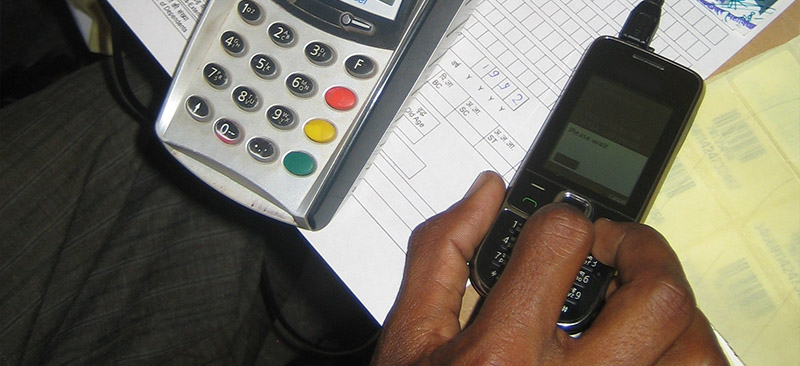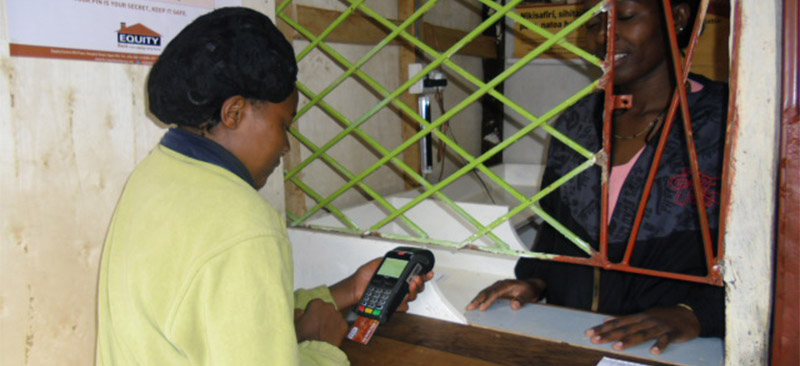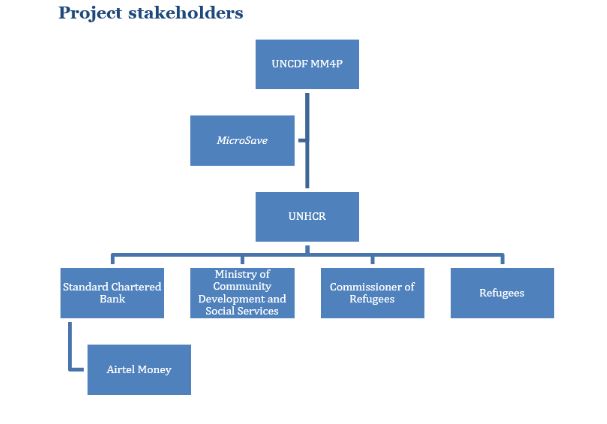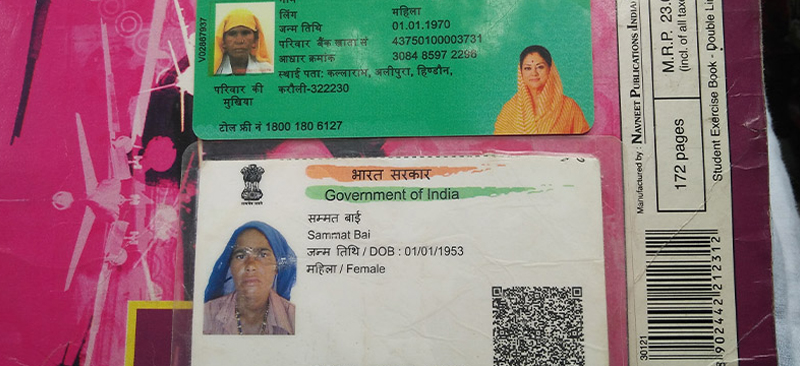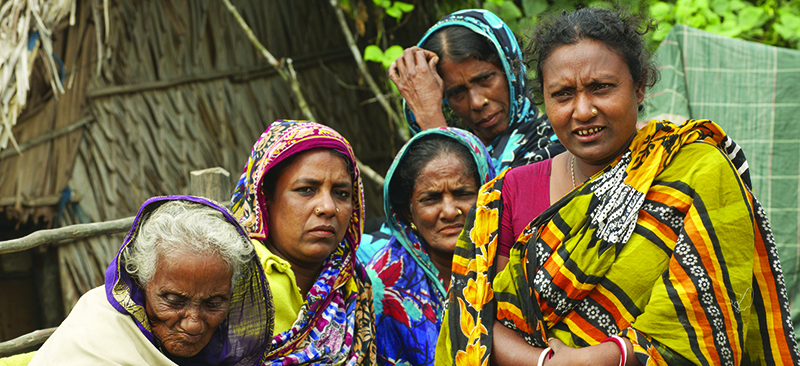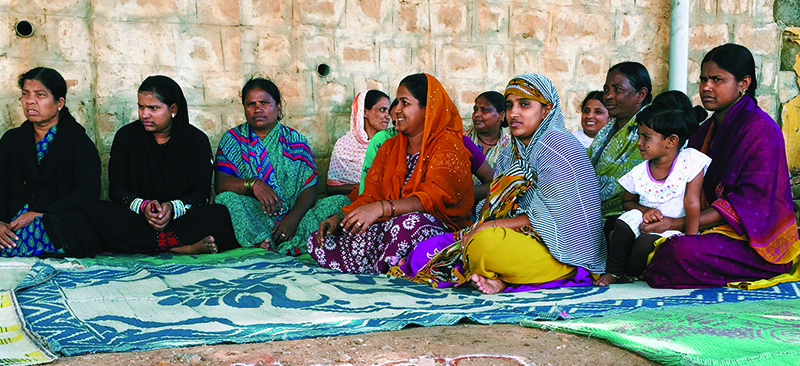A wage labourer from Bihar, India, swipes a metro rail card, as he runs to catch a train to a construction site he works at in Delhi. A mother enters a few digits on her Equitel mobile phone to pay the monthly school fee of her daughter in remote Eldoret, Kenya. A small shop owner outside of Pokhara, Nepal, pays cash to an IME agent to transfer to a consumer goods supplier in the capital Kathmandu. A housewife in Badlapur in the deep suburbs of Mumbai, India, orders a new thirty-dollar smartphone through Amazon and selects the option of ‘cash on delivery’. The smartphone is delivered to her next day by a boy running a small store around the corner. A garment worker in Dhaka hands over some savings in cash from his weekly earnings to a bKash agent to transfer to his wife in rural Chittagong, Bangladesh. A retired soldier swipes his fingers to authenticate and withdraw his monthly pension in cash at a SAVE agent in distant Gonda, Uttar Pradesh, India. A coffee farmer in Masaka, Uganda goes to a MTN agent to withdraw cash paid into her account by an aggregator for Nescafe.
What is common in these events? These are examples of massive and thriving, consumer demand-driven business models in emerging markets around the world. What leads to these success stories that many a business in the payments space would aspire to? A vital element is the low friction of these transactions from the standpoint of the consumers and the distribution/delivery channels. And what constitutes “friction”? Inconvenience, high tariffs, system downtime, low commissions, slow speed, poor service quality, inaccuracy, lack of an underlying compelling need and technology instability, to name the important ones.
Reducing friction can make a difference
An ability to reduce friction makes all the difference between the winners and the also-rans. For every Safaricom, bKash and MTN, there are hundreds of mobile money offerings that haven’t reached any noticeable scale (a mere 21 out of 255 mobile money deployments across 89 countries, tracked by GSMA-MMU, had more than one million active accounts as of December 2014). Likewise, for every Alipay, Amazon and Flipkart, there are countless “alsoran” payment services and wallets.
In this blog, I present a perspective on the upcoming Payment Banks in India – what they will be up against; a reality check amidst the hype; and the acute need for a sharp focus on reducing friction through disruptive innovations and business models.
Understanding the limited degrees of freedom for the Payments Banks
Payments Banks is somewhat of a misnomer. They can certainly do more than provide just payment or remittance services. They can accept demand deposits (current and savings deposits) with an end of the day balance of up to INR 100,000 per individual customer. They can issue ATM/Debit cards and provide Internet banking; function as a business correspondent (or an agent) for a (full service) bank; distribute simple third party financial products such as mutual funds, insurance and/or pension products (albeit after prior approval from the central bank); and undertake utility payments.
However, unlike full service banks, they cannot accept time deposits or undertake any form of lending activities. At least 75% of their ‘demand deposit balances’ have to be invested in government securities or treasury bills as statutory liquidity ratio (SLR). The remaining can be held in current and time deposits with scheduled commercial banks. They need to maintain the stipulated cash reserve ratio (CRR) with the central bank for their ‘outside demand deposit and time liabilities’.
This does considerably limits the degrees of freedom for Payments Banks. RBI data for all scheduled commercial banks for the period 2012 to 2014 shows that 66% of their total earnings are from interest on advances; another 21% are from investments; fee, commission and brokerage income is in the range of 6% to 7%; while 1% is earned on balances with RBI and other inter-bank funds. Therefore Payments Banks have an opportunity to target less than 10% of the revenue streams available to scheduled commercial banks. However they are expected to be game changers and should not be limited to traditional revenue streams. For one, they can potentially earn a lot more on fees from remittances, transfers and payments. Let us take a closer look at how that might pan out.
Avoiding the danger of over dependence on consumer tariffs for a business case
The most prominent, and much written about, remittance and payment business models in Africa, particularly East Africa (e.g. Lipa na M-PESA, M- Shwari, Equity Bank, MTN, Airtel Money), earn primarily from customer tariffs. Below is a comparison of tariffs for diverse mobile money models to transfer an equivalent of USD 100 in the respective local currencies on a purchasing power parity (PPP) basis.
 As can be observed, the tariffs for most of the East African providers, and in Pakistan and Indonesia are quite high on a purchasing power parity (PPP) basis. Some providers like M-Shwari charge as high as 7.5% facility fee on small loans for 30 days. This is a flat rate and remains the same even if the loan is taken just for a day; and it translates to an annualised interest rate of at least 138%.
As can be observed, the tariffs for most of the East African providers, and in Pakistan and Indonesia are quite high on a purchasing power parity (PPP) basis. Some providers like M-Shwari charge as high as 7.5% facility fee on small loans for 30 days. This is a flat rate and remains the same even if the loan is taken just for a day; and it translates to an annualised interest rate of at least 138%.
In India, earnings which are solely from high consumer tariffs are coming under pressure. The payments space is witnessing hyper competition with several national banks doing quite well along with many of the PPI (PrePaid Instrument) licensees or business correspondent partners who have not received a Payments Bank license (Oxigen, ItzCash, Suvidhaa, SAVE et al). In addition, new players/models are emerging. These include: Apple Pay, Samsung and Android Pay, besides a multitude of wallets (Chillr from HDFC Bank, Buddy from SBI, Pockets from ICICI Bank, FreeCharge from Snapdeal to name a few). Payments Banks’ pricing models will compete head on with many of these, and face an added pressure to offer highly attractive tariffs to even draw the attention of consumers in such a crowded market place.
Constant innovation to compete with disruptive models
The second and perhaps a more important factor will be disruptive pricing models. In China and India, some of these alternate models have already taken deep roots. Alipay and AliExpress with 800 million registered (and 400 million active) users making 171 million transactions daily, do not charge the buyers anything for their services. Instead, the business model depends on generating revenue from sellers or partners. Flipkart, Snapdeal and Amazon follow a similar model in India. In Nepal, eSewa virtually offers most of its services free to registered users. These include merchant and bill payments. Remember how mobile voice (and now data) tariffs fell from INR 16 per minute to a per-second pulse in a period of five years?
Coopetition with the right partners will be crucial. Partnerships to offer innovative micro-credit, micro-insurance and other financial products will be crucial to go beyond the limited 10% revenue streams that Payments Banks can target on their own. Fino PayTech and Snapdeal’s announced partnership and Janajeevan prepaid card from Janalakshmi (a small finance bank licensee) with DCB Bank illustrates this need. Though collusion might prove to be short-sighted.
Navigating the dynamics and limitations of retail distribution
Beyond reasonable price points, and assuming Payments Banks’ products have a consumer pull, convenience through widespread, 24 hours and 7 days (or even 12 by 5) availability, and quality of service at the transaction points are very important considerations for consumers. To offer these, financial service providers are highly dependent on distribution channels. Nearly two thirds of the Payments Banks have received the licenses partly on the strength of their distribution networks. The caveat is – these are diverse, third party and multi-brand distribution / retail networks that function entirely on sound commercial opportunities. There is no aspect of loyalty or permanency to them. (This is one of the reasons that despite extensive distribution and outreach, MNOs as PPIs could not make significant inroads into mobile money business. What they will do differently as Payments Banks is yet to be seen).
Moreover, and sadly so, retailers can have considerable downward influence by bad-mouthing a product or simply by limiting its visibility on their shelves, until the product or service (even from a renowned brand) has attained high consumer pull. In their one-upmanship to gain adequate traction with distributors and retailers, Payments Banks will be required to offer large commissions. In the end, those with deeper pockets might survive this war. And as Vinod Khosla, the renowned investor put it, ‘Bad ideas, and copycats will throw a lot of money in blowing each other’s tanks, but might not eventually survive’.
 Retail networks in India are best suited for quick, low-involvement, sales transactions – not for selling of new products or ideas. In a descending order of priority, retailers’ strategy is to: (a) push what fetches them a higher commission; (b) sell what consumers ask for, without a willingness to explore alternatives; and (c) spend time on what provides a high return on time invested (ROTI) to them. As a result, achieving a desired service quality or directing retailers’ behaviour is quite an uphill task (except within the organised retail outlets – company/franchisee owned and operated (COCO/FOFO), that, given their cost structure, can usually be very small in numbers).
Retail networks in India are best suited for quick, low-involvement, sales transactions – not for selling of new products or ideas. In a descending order of priority, retailers’ strategy is to: (a) push what fetches them a higher commission; (b) sell what consumers ask for, without a willingness to explore alternatives; and (c) spend time on what provides a high return on time invested (ROTI) to them. As a result, achieving a desired service quality or directing retailers’ behaviour is quite an uphill task (except within the organised retail outlets – company/franchisee owned and operated (COCO/FOFO), that, given their cost structure, can usually be very small in numbers).
Does this mean, one of the fundamental reasons why several Payments Banks received a license in the first place, the strength of their distribution, might come to a naught? Possibly! Unless they can apply implement the various lessons learned and do more of what is really warranted.
Making the right technology and user interface choices
Another key factor that determines user experience (more importantly retailer experience, as self-service transactions by the masses are still a distance away) is technology – the cost and ease to install/access; the user interface design; the steps to navigate; the speed to transact; the accuracy of transaction fulfilment; the ease of exception management and grievance management. While the USSD channel is the most prevalent form around the world, in India, Internet enabled and POS devices (including micro-ATMs) have a substantial adoption and acceptance rate. Payments Banks with MNO lineage will enjoy some advantage with USSD. After all, the MNOs managed to vanquish Movida India, a joint venture of Visa and Monitisethat was heavily dependent on viable pricing and availability of USSD channels.
Nevertheless, interface options beyond USSD will continue to be vital and so would be seamlessness of transactions routed through national switches. During a MicroSave internal market research, several retailers were found to be swapping providers that provided better navigation options or managed to contain failures of / delays in transactions routed through NEFT or IMPS at the back end. The decision to swap was taken almost instantaneously, without pondering much about the vintage of their previous relationship – so much for their loyalty! While this can be interpreted as an opportunity for the incumbent Payment Banks to make inroads into competitive retailers, it will require them to be always at the cutting edge of delivering a seamless retailer (and user) experience. And of course, there is always the risk that another smarter player will arrive and snatch a well-oiled network, proving MicroSave’s oft-repeated early mover disadvantage in mobile money and payments.
Bottom line: Inevitable need for a compelling consumer value proposition
The bigger question is, will efforts towards reducing friction eventually lead to a higher consumer demand and adoption? Not necessarily. These are necessary but not sufficient requirements. Consumer demand is the outcome of a compelling value proposition delivered through suitable products and services that address needs, better than prevailing options. Lower friction is a critical constituent but it does not complete the equation.
Nevertheless, as Nanden Nilekani says, ‘There will be winners and losers in any hyper competitive market. The good news is, the sector will be transformed and customers will benefit”. Watch this space for more views on strategies for Payments Banks.
